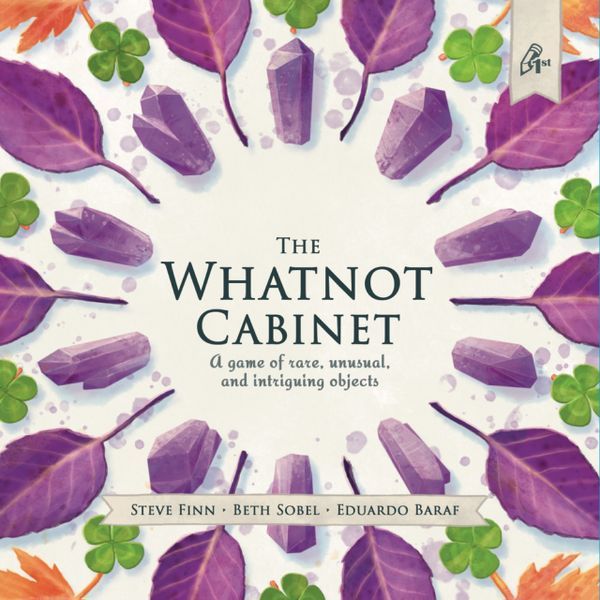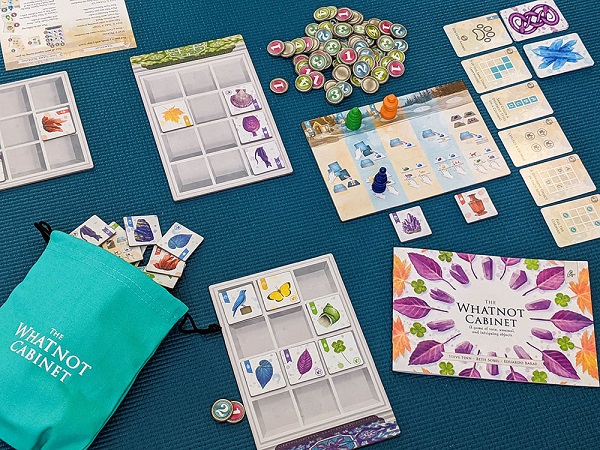Build Your Collection of Precious Objects in The Whatnot Cabinet

Collect all the beautiful tiny objects out in the world, from autumn leaves and seashells to glass bottles and crystals. Whose collection will be the best?
Published by Pencil First Games, The Whatnot Cabinet plays in only twenty minutes. It is a thoughtful game in which each action matters.
Gameplay
Each player takes a cabinet board, each of which has three columns of four rows. Each player also takes a player pawn in their color and a random turn order is chosen for the first round. You then draw four curio tiles from the bag and place them face-up on the table.
During each round of the game, players take turns selecting one of the five actions on the action board. These actions are numbered one through five — the number you select determines turn order in the next round, and no player can select the same action. Action one has you drawing three curio tiles from the bag, taking two, and discarding the third face-down. Action two has you drawing two tiles, taking one, and then placing the other in the display before selecting a second tile from the display. Action three has you adding a tile to the display and then choosing two. Action four has you adding two tiles to the display and then choosing two. Finally, action four has you discarding all the tiles in the display, drawing four new ones from the bag, and then selecting two.
Curio tiles show one of five objects in one of five colors. There are also two special types of curio tiles which, when you gain them, have you immediately perform an action. One has you discard the tiles in the display and draw four new ones before selecting one tile. The other one is worth one point at the end of the game and also has you draw a tile from the bag.
After you perform your action, you add your two tiles to any two empty spaces on your cabinet board. Once a tile has been placed it cannot be moved. When a row or column is completely filled on your board, you add a point token to it. You earn a four-point token for a column with objects of all the same color and two points for one of all different colors. You earn three points for a row of all the same object type and one point for a row with all different objects. If a row or column does not meet any of these requirements, you place a zero-point token on it.
At the start of the game, five curiosity cards are dealt face-up. Each one has a special goal to complete, such as a certain set of curio tiles to collect or a pattern to make with the tiles in your cabinet. The first player to meet the requirements of a curiosity card gets to take it and score its points at the end of the game. There is also one wonder card that is dealt at the start. This tells you which type of object is worth one point for each copy of it that you have in your cabinet at the end. Some curio tiles will also have a crown icon. Each crown icon in your cabinet is worth an additional point.

Review
The Whatnot Cabinet does an excellent job of keeping the rules simple but the puzzle challenging. You have a select number of actions to choose from, and you only perform one each turn, but you’re constantly trying to figure out how best to maximize your points while adapting to what tiles or even actions are still available on your turn.
You’re trying to get the most points out of each row or column, while competing for the curiosity cards, and keeping in mind which item will score extra points at the end of the game. All of these competing scoring goals can be challenging to juggle, and it’s easy to find yourself regretting a past tile placement once it’s already too late to change it.
The game is beautiful, with elegant and attractive artwork, exactly what a game about collecting small, beautiful items should have. The iconography can be a little tricky when you’re first learning the game, and the player aid cards don’t always help here, so this can slow down the game when you’re first learning the mechanics. However, all the components are nice and solid, and the pawns in particular are nicely made. There is something quite tranquil in both the theme and presentation of The Whatnot Cabinet.
There is a little extra setup for two players (including a tedious removal of certain tiles from the game) and a couple of extra rules (each player has two pawns, and the game only lasts three rounds) but the game adapts quite well to this mode and it scales nicely across all player counts.
This is a quick, fast-playing game with an excellent scoring system. It lives up to the high standard that Pencil First Games has already set on multiple occasions.
Pros: Gameplay speed, scoring system, scales well across player count, component quality
Cons: Confusing iconography, setup for a two-player game can be tedious
Disclosure: we received a complimentary review copy of this game.







